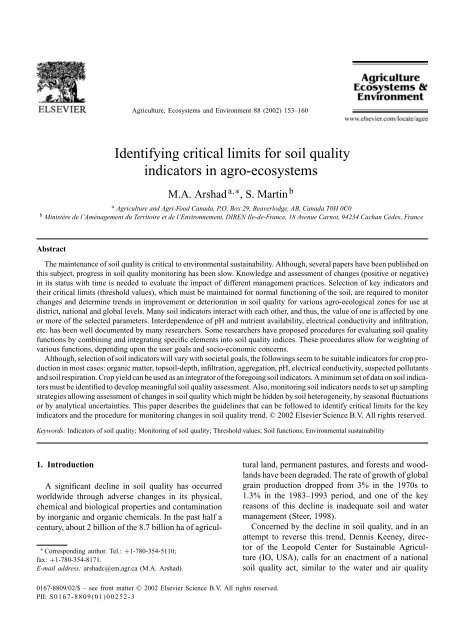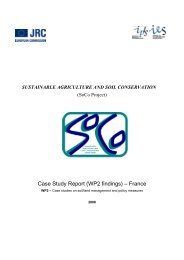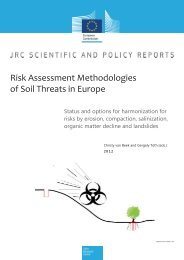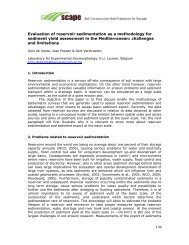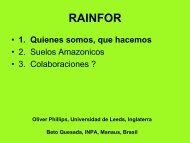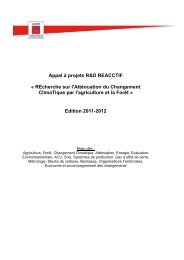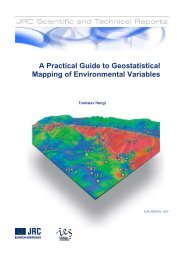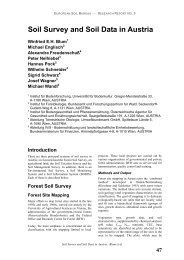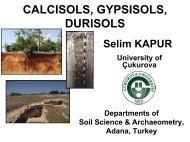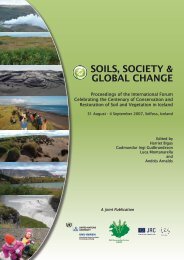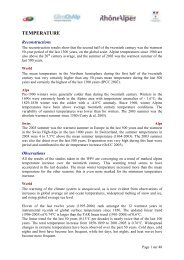Identifying critical limits for soil quality indicators in agro-ecosystems
Identifying critical limits for soil quality indicators in agro-ecosystems
Identifying critical limits for soil quality indicators in agro-ecosystems
You also want an ePaper? Increase the reach of your titles
YUMPU automatically turns print PDFs into web optimized ePapers that Google loves.
Agriculture, Ecosystems and Environment 88 (2002) 153–160<br />
<strong>Identify<strong>in</strong>g</strong> <strong>critical</strong> <strong>limits</strong> <strong>for</strong> <strong>soil</strong> <strong>quality</strong><br />
<strong><strong>in</strong>dicators</strong> <strong>in</strong> <strong>agro</strong>-<strong>ecosystems</strong><br />
M.A. Arshad a,∗ , S. Mart<strong>in</strong> b<br />
a Agriculture and Agri-Food Canada, P.O. Box 29, Beaverlodge, AB, Canada T0H 0C0<br />
b M<strong>in</strong>istère de l’Aménagement du Territoire et de l’Environnement, DIREN Ile-de-France, 18 Avenue Carnot, 94234 Cachan Cedex, France<br />
Abstract<br />
The ma<strong>in</strong>tenance of <strong>soil</strong> <strong>quality</strong> is <strong>critical</strong> to environmental susta<strong>in</strong>ability. Although, several papers have been published on<br />
this subject, progress <strong>in</strong> <strong>soil</strong> <strong>quality</strong> monitor<strong>in</strong>g has been slow. Knowledge and assessment of changes (positive or negative)<br />
<strong>in</strong> its status with time is needed to evaluate the impact of different management practices. Selection of key <strong><strong>in</strong>dicators</strong> and<br />
their <strong>critical</strong> <strong>limits</strong> (threshold values), which must be ma<strong>in</strong>ta<strong>in</strong>ed <strong>for</strong> normal function<strong>in</strong>g of the <strong>soil</strong>, are required to monitor<br />
changes and determ<strong>in</strong>e trends <strong>in</strong> improvement or deterioration <strong>in</strong> <strong>soil</strong> <strong>quality</strong> <strong>for</strong> various <strong>agro</strong>-ecological zones <strong>for</strong> use at<br />
district, national and global levels. Many <strong>soil</strong> <strong><strong>in</strong>dicators</strong> <strong>in</strong>teract with each other, and thus, the value of one is affected by one<br />
or more of the selected parameters. Interdependence of pH and nutrient availability, electrical conductivity and <strong>in</strong>filtration,<br />
etc. has been well documented by many researchers. Some researchers have proposed procedures <strong>for</strong> evaluat<strong>in</strong>g <strong>soil</strong> <strong>quality</strong><br />
functions by comb<strong>in</strong><strong>in</strong>g and <strong>in</strong>tegrat<strong>in</strong>g specific elements <strong>in</strong>to <strong>soil</strong> <strong>quality</strong> <strong>in</strong>dices. These procedures allow <strong>for</strong> weight<strong>in</strong>g of<br />
various functions, depend<strong>in</strong>g upon the user goals and socio-economic concerns.<br />
Although, selection of <strong>soil</strong> <strong><strong>in</strong>dicators</strong> will vary with societal goals, the follow<strong>in</strong>gs seem to be suitable <strong><strong>in</strong>dicators</strong> <strong>for</strong> crop production<br />
<strong>in</strong> most cases: organic matter, top<strong>soil</strong>-depth, <strong>in</strong>filtration, aggregation, pH, electrical conductivity, suspected pollutants<br />
and <strong>soil</strong> respiration. Crop yield can be used as an <strong>in</strong>tegrator of the <strong>for</strong>ego<strong>in</strong>g <strong>soil</strong> <strong><strong>in</strong>dicators</strong>. A m<strong>in</strong>imum set of data on <strong>soil</strong> <strong><strong>in</strong>dicators</strong><br />
must be identified to develop mean<strong>in</strong>gful <strong>soil</strong> <strong>quality</strong> assessment. Also, monitor<strong>in</strong>g <strong>soil</strong> <strong><strong>in</strong>dicators</strong> needs to set up sampl<strong>in</strong>g<br />
strategies allow<strong>in</strong>g assessment of changes <strong>in</strong> <strong>soil</strong> <strong>quality</strong> which might be hidden by <strong>soil</strong> heterogeneity, by seasonal fluctuations<br />
or by analytical uncerta<strong>in</strong>ties. This paper describes the guidel<strong>in</strong>es that can be followed to identify <strong>critical</strong> <strong>limits</strong> <strong>for</strong> the key<br />
<strong><strong>in</strong>dicators</strong> and the procedure <strong>for</strong> monitor<strong>in</strong>g changes <strong>in</strong> <strong>soil</strong> <strong>quality</strong> trend. © 2002 Elsevier Science B.V. All rights reserved.<br />
Keywords: Indicators of <strong>soil</strong> <strong>quality</strong>; Monitor<strong>in</strong>g of <strong>soil</strong> <strong>quality</strong>; Threshold values; Soil functions; Environmental susta<strong>in</strong>ability<br />
1. Introduction<br />
A significant decl<strong>in</strong>e <strong>in</strong> <strong>soil</strong> <strong>quality</strong> has occurred<br />
worldwide through adverse changes <strong>in</strong> its physical,<br />
chemical and biological properties and contam<strong>in</strong>ation<br />
by <strong>in</strong>organic and organic chemicals. In the past half a<br />
century, about 2 billion of the 8.7 billion ha of agricul-<br />
∗ Correspond<strong>in</strong>g author. Tel.: +1-780-354-5110;<br />
fax: +1-780-354-8171.<br />
E-mail address: arshadc@em.agr.ca (M.A. Arshad).<br />
0167-8809/02/$ – see front matter © 2002 Elsevier Science B.V. All rights reserved.<br />
PII: S0167-8809(01)00252-3<br />
tural land, permanent pastures, and <strong>for</strong>ests and woodlands<br />
have been degraded. The rate of growth of global<br />
gra<strong>in</strong> production dropped from 3% <strong>in</strong> the 1970s to<br />
1.3% <strong>in</strong> the 1983–1993 period, and one of the key<br />
reasons of this decl<strong>in</strong>e is <strong>in</strong>adequate <strong>soil</strong> and water<br />
management (Steer, 1998).<br />
Concerned by the decl<strong>in</strong>e <strong>in</strong> <strong>soil</strong> <strong>quality</strong>, and <strong>in</strong> an<br />
attempt to reverse this trend, Dennis Keeney, director<br />
of the Leopold Center <strong>for</strong> Susta<strong>in</strong>able Agriculture<br />
(IO, USA), calls <strong>for</strong> an enactment of a national<br />
<strong>soil</strong> <strong>quality</strong> act, similar to the water and air <strong>quality</strong>
154 M.A. Arshad, S. Mart<strong>in</strong> / Agriculture, Ecosystems and Environment 88 (2002) 153–160<br />
legislation with an emphasis on a strong, co-ord<strong>in</strong>ated<br />
research-demonstration-<strong>in</strong>centives approach. When<br />
<strong>soil</strong>s are degraded to the level that they can no longer<br />
per<strong>for</strong>m their ecosystem functions, restoration is slow,<br />
expensive, and uncerta<strong>in</strong>. “How many waste sites<br />
have been truly reclaimed?” “How many salt slicks<br />
made productive?” Asks Keeney. Any nation or state<br />
that supports an ecosystem that degrades <strong>soil</strong> is not<br />
susta<strong>in</strong>able (Keeney, 1999).<br />
In 1996, a review by the Consultative Group of<br />
International Agricultural Research (CGIAR) of 14<br />
<strong>in</strong>ternational research centers found good progress<br />
<strong>in</strong> reorient<strong>in</strong>g their research towards <strong>soil</strong> and water<br />
management, but it also found <strong>in</strong>adequate attention<br />
paid to off-site <strong>in</strong>teractions at the river bas<strong>in</strong> and<br />
regional levels (Steer, 1998). This was of particular<br />
concern s<strong>in</strong>ce, off-site costs of unsusta<strong>in</strong>able management<br />
practices are often greater than their impacts on<br />
on-site productivity.<br />
The <strong>soil</strong>, like air and water, is an <strong>in</strong>tegral component<br />
of our environment, and together with water constitutes<br />
the most important natural resource. The wise<br />
use of this vital resource is essential <strong>for</strong> susta<strong>in</strong>able<br />
development and feed<strong>in</strong>g the grow<strong>in</strong>g world population.<br />
In the past decade, several studies have dealt<br />
with the selection of suitable criteria <strong>for</strong> assessment<br />
of <strong>soil</strong> <strong>quality</strong>. However, monitor<strong>in</strong>g of changes <strong>in</strong><br />
<strong>soil</strong> <strong>quality</strong>, result<strong>in</strong>g from various management systems,<br />
have been slow. Selection of key <strong><strong>in</strong>dicators</strong> and<br />
their threshold values, which must be ma<strong>in</strong>ta<strong>in</strong>ed <strong>for</strong><br />
normal function<strong>in</strong>g of the <strong>soil</strong>, are required to monitor<br />
changes (direction, rate, magnitude, extent, etc.),<br />
and determ<strong>in</strong>e trends <strong>in</strong> improvement or deterioration<br />
<strong>in</strong> <strong>soil</strong> <strong>quality</strong> <strong>for</strong> various <strong>ecosystems</strong>.<br />
The objectives of this paper are: (1) to review work<br />
done <strong>in</strong> the last decade on <strong><strong>in</strong>dicators</strong> <strong>for</strong> <strong>soil</strong> <strong>quality</strong><br />
assessment; (2) to propose guidel<strong>in</strong>es that can be followed<br />
to identify <strong>critical</strong> <strong>limits</strong> <strong>for</strong> the key <strong><strong>in</strong>dicators</strong>,<br />
and (3) describe a procedure <strong>for</strong> monitor<strong>in</strong>g changes<br />
<strong>in</strong> <strong>soil</strong> <strong>quality</strong> trends.<br />
2. Def<strong>in</strong><strong>in</strong>g <strong>soil</strong> <strong>quality</strong><br />
Many def<strong>in</strong>itions of <strong>soil</strong> <strong>quality</strong> have been proposed<br />
<strong>in</strong> the last 10 years (Arshad and Coen, 1992; Doran<br />
and Park<strong>in</strong>, 1994; Karlen et al., 1997) with similar<br />
elements. The most recent, proposed by Karlen and<br />
a committee <strong>for</strong> the Soil Science Society of America<br />
is as follows: “the fitness of a specific k<strong>in</strong>d of <strong>soil</strong>,<br />
to function with<strong>in</strong> its capacity and with<strong>in</strong> natural or<br />
managed ecosystem boundaries, to susta<strong>in</strong> plant and<br />
animal productivity, ma<strong>in</strong>ta<strong>in</strong> or enhance water and air<br />
<strong>quality</strong>, and support human health and habitation”.<br />
The various functions of <strong>soil</strong>, as <strong>for</strong> land, described<br />
by Sombroek and Sims (FAO, 1995) <strong>in</strong> their background<br />
paper, are:<br />
• production function;<br />
• biotic environmental function;<br />
• climate-regulative function;<br />
• hydrologic function;<br />
• storage function;<br />
• waste and pollution control function;<br />
• liv<strong>in</strong>g space function;<br />
• archive or heritage function;<br />
• connective space function.<br />
In this context, land refers not just to <strong>soil</strong>, but to the<br />
comb<strong>in</strong>ed resources of <strong>soil</strong>, water, vegetation and terra<strong>in</strong><br />
that provide the basis <strong>for</strong> land use. Land <strong>quality</strong> is<br />
the condition or health of land relative to its capacity<br />
<strong>for</strong> susta<strong>in</strong>able land use and environmental management<br />
(Dumanski, J. and Pieri, C. <strong>in</strong> FAO, 1997).<br />
3. Soil <strong>quality</strong> <strong>in</strong>dices<br />
Three basic components of a <strong>soil</strong> <strong>quality</strong> <strong>in</strong>dex<br />
were proposed at the International Conference on<br />
the Assessment and Monitor<strong>in</strong>g of Soil Quality held<br />
at the Rodale Institute (Rodale Institute, 1991). The<br />
components were: (1) the ability of <strong>soil</strong> to enhance<br />
crop production (productivity component); (2) the<br />
ability of <strong>soil</strong> to function <strong>in</strong> attenuation of environmental<br />
contam<strong>in</strong>ants, pathogens, and offsite damage<br />
(environment component); and (3) the l<strong>in</strong>kage between<br />
<strong>soil</strong> <strong>quality</strong> and plant, animal and human health<br />
(health component). At this conference, Parr et al.<br />
(1992), proposed a <strong>soil</strong> <strong>quality</strong> <strong>in</strong>dex (SQ) as follows:<br />
SQ = f(SP,P,E,H,ER, BD, FQ, MI) (1)<br />
where SP are the <strong>soil</strong> properties, P the potential productivity,<br />
E the environmental factors, H the health<br />
(human/animal), ER the erodibility, BD the biological<br />
diversity, FQ the food <strong>quality</strong>/safety and MI are<br />
management <strong>in</strong>puts.
Table 1<br />
Interrelationship of <strong>soil</strong> <strong><strong>in</strong>dicators</strong><br />
M.A. Arshad, S. Mart<strong>in</strong> / Agriculture, Ecosystems and Environment 88 (2002) 153–160 155<br />
Selected <strong>in</strong>dicator Other <strong>soil</strong> <strong>quality</strong> <strong><strong>in</strong>dicators</strong> <strong>in</strong> the MDS affect<strong>in</strong>g the selected <strong>in</strong>dicator<br />
Aggregation Organic matter, microbial (especially fungal) activity, texture<br />
Infiltration Organic matter, aggregation, electrical conductivity, exchangeable<br />
sodium percentage (ESP)<br />
Bulk density Organic matter, aggregation, top<strong>soil</strong>-depth, ESP, biological activity<br />
Microbial biomass and/or respiration Organic matter, aggregation, bulk density, pH, texture, ESP<br />
Available nutrients Organic matter, pH, top<strong>soil</strong>-depth, texture, microbial parameters<br />
(m<strong>in</strong>eralization and immobilization rates)<br />
Subsequent to the Rodale Conference, many <strong>soil</strong><br />
scientists have proposed more detailed procedures<br />
<strong>for</strong> evaluat<strong>in</strong>g <strong>soil</strong> <strong>quality</strong> functions by comb<strong>in</strong><strong>in</strong>g<br />
and <strong>in</strong>tegrat<strong>in</strong>g specific <strong>soil</strong> <strong>quality</strong> elements <strong>in</strong>to <strong>soil</strong><br />
<strong>quality</strong> <strong>in</strong>dices (Doran and Park<strong>in</strong>, 1994; Karlen and<br />
Stott, 1994). These procedures allow <strong>for</strong> weight<strong>in</strong>g of<br />
various functions, depend<strong>in</strong>g upon the user goals and<br />
socio-economic concerns.<br />
Doran and Park<strong>in</strong> (1994) described a per<strong>for</strong>mance<br />
based <strong>in</strong>dex of <strong>soil</strong> <strong>quality</strong> that could be used to provide<br />
an evaluation of <strong>soil</strong> function with regard to the<br />
major issues of (i) susta<strong>in</strong>able production, (ii) environmental<br />
<strong>quality</strong>, and (iii) human and animal health.<br />
They proposed a <strong>soil</strong> <strong>quality</strong> <strong>in</strong>dex consist<strong>in</strong>g of six<br />
elements:<br />
SQ = f(SQE1, SQE2, SQE3, SQE4, SQE5, SQE6)<br />
(2)<br />
where SQE1 is the food and fibre production, SQE2<br />
the erosivity, SQE3 the ground water <strong>quality</strong>, SQE4<br />
the surface water <strong>quality</strong>, SQE5 the air <strong>quality</strong>, and<br />
SQE6 is the food <strong>quality</strong>.<br />
Accord<strong>in</strong>g to these scientists, advantage of this<br />
approach is that <strong>soil</strong> functions can be assessed based<br />
on specific per<strong>for</strong>mance criteria established <strong>for</strong> each<br />
element, <strong>for</strong> a given ecosystem (<strong>for</strong> details, see Doran<br />
et al., 1997).<br />
4. Soil <strong>quality</strong> <strong><strong>in</strong>dicators</strong><br />
Soil <strong>quality</strong> <strong><strong>in</strong>dicators</strong> refer to measurable <strong>soil</strong> attributes<br />
that <strong>in</strong>fluence the capacity of <strong>soil</strong> to per<strong>for</strong>m<br />
crop production or environmental functions. Attributes<br />
that are most sensitive to management are most desirable<br />
as <strong><strong>in</strong>dicators</strong>. In a given <strong>agro</strong>-climatic region,<br />
the measurable <strong>soil</strong> attributes that are primarily <strong>in</strong>fluenced<br />
are: <strong>soil</strong>-depth, organic matter, respiration, aggregation,<br />
texture, bulk density, <strong>in</strong>filtration, nutrient<br />
availability and retention capacity. A m<strong>in</strong>imum number<br />
of <strong><strong>in</strong>dicators</strong> (m<strong>in</strong>imum data set (MSD)) need to<br />
be measured to evaluate changes <strong>in</strong> <strong>soil</strong> <strong>quality</strong> result<strong>in</strong>g<br />
from various management systems.<br />
4.1. Inter-dependence of <strong>soil</strong> <strong><strong>in</strong>dicators</strong><br />
Many <strong>soil</strong> <strong><strong>in</strong>dicators</strong> <strong>in</strong> the MDS <strong>in</strong>teract with each<br />
other, and thus, values of one is affected by one or<br />
more of these selected parameters. Some examples<br />
are listed <strong>in</strong> Table 1. Chappell et al. (1999) studied<br />
variations <strong>in</strong> aggregate stability <strong>in</strong> a tropical Ultisol<br />
(Borneo, Indonesia) disturbed by various <strong>for</strong>estry operations<br />
(a range of denudational processes <strong>in</strong>clud<strong>in</strong>g<br />
pip<strong>in</strong>g, rill<strong>in</strong>g and landslide-triggered erosion). Differences<br />
<strong>in</strong> aggregate stability were correlated with<br />
organic C, clay content and exchangeable sodium percentage<br />
(ESP) at sites undergo<strong>in</strong>g erosion. Organic C<br />
was the most important govern<strong>in</strong>g factor, account<strong>in</strong>g<br />
<strong>for</strong> 56% of the variance <strong>in</strong> aggregate stability. Similar<br />
results were reported earlier by Franzluebbers and<br />
Arshad (1996). Interdependence of pH and nutrient<br />
availability, electrical conductivity and <strong>in</strong>filtration,<br />
etc. has been well documented by many researchers.<br />
5. Assessment of <strong>soil</strong> <strong>quality</strong><br />
Changes <strong>in</strong> <strong>soil</strong> <strong>quality</strong> can be assessed by measur<strong>in</strong>g<br />
appropriate <strong><strong>in</strong>dicators</strong> and compar<strong>in</strong>g them with<br />
desired values (<strong>critical</strong> <strong>limits</strong> or threshold level), at<br />
different time <strong>in</strong>tervals, <strong>for</strong> a specific use <strong>in</strong> a selected<br />
<strong>agro</strong>-ecosystem. Such a monitor<strong>in</strong>g system will
156 M.A. Arshad, S. Mart<strong>in</strong> / Agriculture, Ecosystems and Environment 88 (2002) 153–160<br />
provide <strong>in</strong><strong>for</strong>mation on the effectiveness of the selected<br />
farm<strong>in</strong>g system, land use practices, technologies<br />
and policies. A farm<strong>in</strong>g system or policies that<br />
contribute negatively to any of the selected <strong><strong>in</strong>dicators</strong><br />
could be considered potentially unsusta<strong>in</strong>able and<br />
thus, discouraged or modified. Systems that improve<br />
per<strong>for</strong>mance of the <strong><strong>in</strong>dicators</strong> can be promoted and<br />
advanced to assure susta<strong>in</strong>ability.<br />
5.1. <strong>Identify<strong>in</strong>g</strong> <strong>critical</strong> <strong>limits</strong><br />
While many papers and reports have been published<br />
<strong>in</strong> the last 5–10 years relat<strong>in</strong>g to the MDS (Arshad and<br />
Coen, 1992; Doran and Park<strong>in</strong>, 1994; Gregorich et al.,<br />
1994; Larson and Pierce, 1994; Karlen et al., 1997;<br />
Mart<strong>in</strong> et al., 1998, Table 2), limited ef<strong>for</strong>t has been<br />
made to determ<strong>in</strong>e threshold values or <strong>critical</strong> <strong>limits</strong><br />
<strong>for</strong> the proposed <strong>soil</strong> <strong><strong>in</strong>dicators</strong>.<br />
What is a <strong>critical</strong> limit? It is the desirable range of<br />
values <strong>for</strong> a selected <strong>soil</strong> <strong>in</strong>dicator that must be ma<strong>in</strong>ta<strong>in</strong>ed<br />
<strong>for</strong> normal function<strong>in</strong>g of the <strong>soil</strong> ecosystem<br />
health. With<strong>in</strong> this <strong>critical</strong> range, the <strong>soil</strong> per<strong>for</strong>ms its<br />
specific functions <strong>in</strong> natural <strong>ecosystems</strong>. For example,<br />
to grow most crops the pH may be 6.5–7.0 or<br />
<strong>soil</strong>-depth may be 50 cm or more.<br />
Selection of <strong>critical</strong> <strong>limits</strong> <strong>for</strong> <strong>soil</strong> <strong>quality</strong> <strong><strong>in</strong>dicators</strong><br />
poses several difficult problems. The ability to supply<br />
Table 2<br />
Key <strong>soil</strong> <strong><strong>in</strong>dicators</strong> <strong>for</strong> <strong>soil</strong> <strong>quality</strong> assessment (after Arshad and Coen, 1992; Doran and Park<strong>in</strong>, 1994; Gregorich et al., 1994; Larson and<br />
Pierce, 1994; Carter et al., 1997; Karlen et al., 1997; Mart<strong>in</strong> et al., 1998)<br />
Selected <strong>in</strong>dicator Rationale <strong>for</strong> selection<br />
moisture, nutrients and physical root<strong>in</strong>g support <strong>in</strong><br />
the absence of toxic substances can be affected by<br />
many physical, chemical and biological parameters.<br />
A detrimental change <strong>in</strong> any of these can reduce the<br />
<strong>quality</strong> of the <strong>soil</strong>, but the quantitative values beyond<br />
which a further reduction <strong>in</strong> these properties is limit<strong>in</strong>g<br />
depend strongly on the crop. For example, a<br />
pH below about 6.5 reduces the yield of alfalfa, but<br />
pH must drop below about 4.0 be<strong>for</strong>e <strong>critical</strong> yield<br />
reduction occur <strong>in</strong> blueberries (Doll, 1964). A <strong>critical</strong><br />
limit of a <strong>soil</strong> <strong>in</strong>dicator can be ameliorated or<br />
exacerbated by <strong>limits</strong> of other <strong>soil</strong> properties and the<br />
<strong>in</strong>teractions among <strong>soil</strong> <strong>quality</strong> <strong><strong>in</strong>dicators</strong> (Table 1).<br />
Given the complexities of yield response to <strong>critical</strong><br />
<strong>soil</strong> parameter values, perhaps, the best we can do is<br />
to develop a set of guidel<strong>in</strong>es that can help set <strong>limits</strong><br />
<strong>for</strong> def<strong>in</strong>ed crop/environment situations. In watershed<br />
analysis, the potential optimum function<strong>in</strong>g of watersheds<br />
can be obta<strong>in</strong>ed from study<strong>in</strong>g the best of the<br />
undisturbed <strong>ecosystems</strong> (Warkent<strong>in</strong>, 1996). A similar<br />
procedure is used when <strong>soil</strong>s that have been under a<br />
certa<strong>in</strong> land management <strong>for</strong> a number of years are<br />
compared with <strong>soil</strong>s that have not been disturbed.<br />
The <strong>in</strong>fluence of climate, especially temperature and<br />
distribution of precipitation, and geomorphology and<br />
weather<strong>in</strong>g rate could be elim<strong>in</strong>ated by compar<strong>in</strong>g<br />
<strong>soil</strong>s only with<strong>in</strong> an ecological region or <strong>soil</strong> type.<br />
Organic matter Def<strong>in</strong>es <strong>soil</strong> fertility and <strong>soil</strong> structure, pesticide and water<br />
retention, and use <strong>in</strong> process models<br />
Top<strong>soil</strong>-depth Estimate root<strong>in</strong>g volume <strong>for</strong> crop production and erosion<br />
Aggregation Soil structure, erosion resistance, crop emergence and early <strong>in</strong>dicator<br />
of <strong>soil</strong> management effect<br />
Texture Retention and transport of water and chemicals, model<strong>in</strong>g use<br />
Bulk density Plant root penetration, porosity, adjust analyses to volumetric basis<br />
Infiltration Runoff, leach<strong>in</strong>g and erosion potential<br />
pH Nutrient availability, pesticide absorption and mobility, process models<br />
Electrical conductivity Def<strong>in</strong>es crop growth, <strong>soil</strong> structure, water <strong>in</strong>filtration; presently<br />
lack<strong>in</strong>g <strong>in</strong> most process models<br />
Suspected pollutants Plant <strong>quality</strong>, and human and animal health<br />
Soil respiration Biological activity, process model<strong>in</strong>g; estimate of biomass activity,<br />
early warn<strong>in</strong>g of management effect on organic matter<br />
Forms of N Availability to crops, leach<strong>in</strong>g potential, m<strong>in</strong>eralization/<br />
immobilization rates, process model<strong>in</strong>g<br />
Extractable N, P and K Capacity to support plant growth, environmental <strong>quality</strong> <strong>in</strong>dicator
M.A. Arshad, S. Mart<strong>in</strong> / Agriculture, Ecosystems and Environment 88 (2002) 153–160 157<br />
Table 3<br />
Threshold levels <strong>for</strong> susta<strong>in</strong>ability <strong><strong>in</strong>dicators</strong> (after Gomez et al., 1996)<br />
Indicator Threshold level<br />
Yield The 20% more than average yield <strong>in</strong> the community<br />
Profit The 20% better than average <strong>in</strong> the community, whichever is lower<br />
Frequency of crop failure The 20% or average frequency <strong>for</strong> the community, which ever is lower<br />
Soil-depth The 50 cm or average of similar <strong>soil</strong> types <strong>in</strong> the community<br />
Organic matter The 1% or average of the community, whichever is higher<br />
Permanent ground cover The 15% or average of the community, whichever is higher<br />
Gomez et al. (1996) proposed a framework <strong>for</strong> evaluat<strong>in</strong>g<br />
susta<strong>in</strong>ability at the farm level <strong>in</strong> the Philipp<strong>in</strong>es<br />
based on field <strong><strong>in</strong>dicators</strong> that take <strong>in</strong>to account both<br />
the farmer’s satisfaction and resource conservation.<br />
High yield, low labor requirement, low <strong>in</strong>put cost, high<br />
profit, and stability are some of the features that are<br />
likely to enhance farmer satisfaction. Natural resource<br />
conservation is usually associated with <strong>soil</strong>-depth, water<br />
hold<strong>in</strong>g capacity, nutrient balance, organic matter<br />
content, ground cover, and biological diversity. Accord<strong>in</strong>g<br />
to these workers, an <strong>in</strong>dicator is said to be at<br />
a susta<strong>in</strong>able level if it exceeds a designated trigger<br />
or threshold level; thresholds are tentatively set, based<br />
on the average local conditions (Table 3).<br />
In Europe, measurable quantities of trace metals<br />
have been added to the environment <strong>for</strong> over 2000<br />
years. Lately, waste and sewage sludges have become<br />
major potential sources of metal pollution of <strong>soil</strong>s. At<br />
present, there is one set of <strong>critical</strong> levels <strong>for</strong> concentrations<br />
of heavy metals <strong>in</strong> <strong>soil</strong>s (Cd, Cu, Ni, Pb, Zn, Hg<br />
and Cr) which apply to all countries of the EU, def<strong>in</strong>ed<br />
<strong>in</strong> annex 1A of the Council Directive 86/278/EEC;<br />
these values should not be exceeded when sewage<br />
sludge is applied <strong>in</strong> agriculture. This directive has<br />
been implemented <strong>in</strong> the <strong>for</strong>m of national laws, with,<br />
<strong>in</strong> many cases, much lower nationally def<strong>in</strong>ed <strong>critical</strong><br />
levels. In addition, <strong>in</strong> many cases, <strong>critical</strong> values were<br />
extended to <strong>soil</strong>s <strong>in</strong> general and not limited to the application<br />
of sewage sludge. Alongside these precautionary<br />
levels, separate <strong>critical</strong> values are established<br />
<strong>for</strong> the clean<strong>in</strong>g up of contam<strong>in</strong>ated sites, based on<br />
functional criteria and health aspects. One of the basic<br />
characters of European environment policy is the precautionary<br />
pr<strong>in</strong>ciple. There<strong>for</strong>e, preference should not<br />
necessarily be given to the scientific approach lead<strong>in</strong>g<br />
to higher permissible metal concentrations <strong>in</strong> <strong>soil</strong>,<br />
but also to other factors which could endanger <strong>soil</strong><br />
<strong>quality</strong> <strong>in</strong> the longer term. The precautionary approach<br />
is aimed at keep<strong>in</strong>g <strong>soil</strong> trace metal concentrations to<br />
average natural concentrations (Re<strong>in</strong>iger, 1997).<br />
6. Models to assess <strong>soil</strong> <strong>quality</strong><br />
The development of relationships between <strong>soil</strong> attributes<br />
and <strong>soil</strong> functions may be a monumental task.<br />
However, algorithms <strong>in</strong> exist<strong>in</strong>g simulation models<br />
(e.g. NLEAP, EPIC, CREAMS, WEPP) may serve a<br />
useful start<strong>in</strong>g po<strong>in</strong>t (Doran and Park<strong>in</strong>, 1994). The<br />
models provide a predictive tool about the process<br />
such that given what we know, if we change one of<br />
the parameters that affect the process, we can predict<br />
the change <strong>in</strong> outcome caused by the change <strong>in</strong><br />
the parameter. We can often measure the th<strong>in</strong>gs that<br />
dom<strong>in</strong>antly affect the process more easily than we can<br />
measure the net effect (Coen, 1996). Models are normally<br />
constructed us<strong>in</strong>g results of detailed long-term<br />
data. Because climatic conditions vary from year to<br />
year, reliable long-term data is mandatory if we wish<br />
to reflect the historical reality and predict future events<br />
with some degree of confidence. Models can assist us<br />
<strong>in</strong> organiz<strong>in</strong>g what we know about <strong>soil</strong> processes and<br />
identify<strong>in</strong>g what we should emphasize <strong>in</strong> research. By<br />
us<strong>in</strong>g <strong>soil</strong> process models, we can predict the rates<br />
and direction of <strong>soil</strong> <strong>quality</strong> change. They can allow<br />
us to simulate various management practices <strong>in</strong> order<br />
to predict their consequences.<br />
7. Requirements <strong>for</strong> monitor<strong>in</strong>g <strong>soil</strong> <strong><strong>in</strong>dicators</strong><br />
The follow<strong>in</strong>g details <strong>in</strong> measur<strong>in</strong>g changes <strong>in</strong> each<br />
selected <strong>in</strong>dicator with<strong>in</strong> a def<strong>in</strong>ed ecological zone required<br />
are as follows.
158 M.A. Arshad, S. Mart<strong>in</strong> / Agriculture, Ecosystems and Environment 88 (2002) 153–160<br />
Fig. 1. An example of sampl<strong>in</strong>g pattern (13 locations; 13 × 4 = 52 sampl<strong>in</strong>g po<strong>in</strong>ts): the “Observatoire de la Qualité des Sols” <strong>in</strong> France<br />
(after Leprêtre and Mart<strong>in</strong>, 1994).<br />
• Direction of change –– positive or negative, <strong>in</strong>crease<br />
or decrease, etc.<br />
• Magnitude of change — percent change over the<br />
basel<strong>in</strong>e values.<br />
• Rate of change — duration: months, years.<br />
• Extent of change — percentage of the area be<strong>in</strong>g<br />
monitored i.e. what percentage of the farm or district<br />
has changed with respect to the selected <strong>in</strong>dicator<br />
dur<strong>in</strong>g a specified period.<br />
Monitor<strong>in</strong>g <strong>soil</strong> <strong><strong>in</strong>dicators</strong> needs to set up sampl<strong>in</strong>g<br />
strategies allow<strong>in</strong>g assessment of changes <strong>in</strong> <strong>soil</strong> <strong>quality</strong><br />
that might be hidden by <strong>soil</strong> heterogeneity, by seasonal<br />
fluctuations or by analytical uncerta<strong>in</strong>ties (Leprêtre<br />
and Mart<strong>in</strong>, 1994; Arshad et al., 1996). A sampl<strong>in</strong>g<br />
strategy is a set of processes that yields a data<br />
set correspond<strong>in</strong>g to the objectives of the study and to<br />
the characteristics of the terra<strong>in</strong>. It <strong>in</strong>cludes a sampl<strong>in</strong>g<br />
pattern (as <strong>in</strong> Fig. 1), analytical procedures, sample<br />
storage, and data management <strong>in</strong> view of statistical<br />
analysis (Leprêtre and Mart<strong>in</strong>, 1994).<br />
Similar qualitative data/observations on <strong>soil</strong> conditions,<br />
land use, cropp<strong>in</strong>g systems, <strong>in</strong>puts/outputs<br />
<strong>in</strong>clud<strong>in</strong>g <strong>in</strong><strong>for</strong>mation provided by the farmer, must<br />
be collected over the monitor<strong>in</strong>g period. A genu<strong>in</strong>e<br />
discussion between scientists and local people is very<br />
important; the scientist can take what is useful from<br />
the local expertise and use the <strong>in</strong><strong>for</strong>mation <strong>in</strong> the<br />
design of the program. It is important to understand<br />
human behavior and then choose policies and technologies<br />
accord<strong>in</strong>gly (Steer, 1998). Understand<strong>in</strong>g<br />
of the factors <strong>in</strong>volved <strong>for</strong> the observed changes,<br />
both socio-economic as well as <strong>agro</strong>-ecological (e.g.<br />
cost of land, availability of labor, capital, etc. skill<br />
of farm managers, and factors beyond their control<br />
such as weather, market conditions, policies and<br />
legislation, technical support, <strong>in</strong>frastructure, etc.),<br />
are also important (Benites et al., <strong>in</strong> FAO, 1997).<br />
Take a multidiscipl<strong>in</strong>ary approach; same situation<br />
or condition is viewed differently by <strong>in</strong>dividuals <strong>in</strong><br />
different discipl<strong>in</strong>es. Thus, it is better to <strong>in</strong>volve<br />
them at the commencement of the project; this will<br />
help <strong>in</strong> ga<strong>in</strong><strong>in</strong>g support from the community, governments<br />
and other agencies throughout the life of the<br />
project.<br />
8. Guidel<strong>in</strong>es <strong>for</strong> monitor<strong>in</strong>g <strong>soil</strong> <strong>quality</strong><br />
The follow<strong>in</strong>g guidel<strong>in</strong>es and steps are suggested to<br />
monitor <strong>soil</strong> <strong>quality</strong>.<br />
1. Divide the region or the country <strong>in</strong>to different ecological<br />
zones.<br />
2. Select the ecological zone, farms or watershed with<br />
similar <strong>soil</strong> types.
M.A. Arshad, S. Mart<strong>in</strong> / Agriculture, Ecosystems and Environment 88 (2002) 153–160 159<br />
3. Def<strong>in</strong>e the goal or requirements <strong>for</strong> susta<strong>in</strong>ability;<br />
the goal could be production of a crop or a group of<br />
crops, environmental protection or any other use.<br />
4. Select a set of <strong><strong>in</strong>dicators</strong> <strong>for</strong> the ecological zone,<br />
farms or watershed. Although, selection of <strong>soil</strong><br />
<strong><strong>in</strong>dicators</strong> will vary with the societal goals, the<br />
follow<strong>in</strong>gs seem to be suitable <strong><strong>in</strong>dicators</strong> <strong>for</strong><br />
crop production <strong>in</strong> most cases: organic matter,<br />
top<strong>soil</strong>-depth, <strong>in</strong>filtration, aggregation, pH, electrical<br />
conductivity, suspected <strong>soil</strong> pollutants and <strong>soil</strong><br />
respiration. Crop yield can be used as an <strong>in</strong>tegrator<br />
of the <strong>for</strong>ego<strong>in</strong>g <strong>soil</strong> <strong><strong>in</strong>dicators</strong>.<br />
5. Select a reference po<strong>in</strong>t (basel<strong>in</strong>e value) <strong>for</strong> each<br />
<strong>in</strong>dicator. This could be the average value of crop<br />
yield/<strong>soil</strong> <strong>in</strong>dicator used <strong>for</strong> the ecological zone<br />
or <strong>soil</strong> type at the commencement of the monitor<strong>in</strong>g<br />
period. In<strong>for</strong>mation from the exist<strong>in</strong>g databases<br />
may be useful to determ<strong>in</strong>e the basel<strong>in</strong>e values <strong>for</strong><br />
different regions.<br />
6. Specify the <strong>critical</strong> <strong>limits</strong> <strong>for</strong> selected <strong><strong>in</strong>dicators</strong>.<br />
Critical <strong>limits</strong> will vary with each <strong>in</strong>dicator. For<br />
some <strong><strong>in</strong>dicators</strong>, a 10% <strong>in</strong>crease or decrease may<br />
be significant while others may not be affected by a<br />
20% decl<strong>in</strong>e. For organic matter, a 15% <strong>in</strong>crease or<br />
decrease over the average or basel<strong>in</strong>e value seems<br />
reasonable to use as a <strong>critical</strong> limit. For example,<br />
if the basel<strong>in</strong>e value of organic carbon is 2%, the<br />
organic matter must <strong>in</strong>crease by 15% or to 2.3%<br />
carbon <strong>in</strong> order <strong>for</strong> us to conclude that a significant<br />
positive change has occurred <strong>in</strong> this <strong>in</strong>dicator.<br />
This value must decrease to 1.7% carbon (negative<br />
change) to signal that a corrective action must be<br />
taken to reverse the trend.<br />
7. Trans<strong>for</strong>m the <strong><strong>in</strong>dicators</strong> <strong>in</strong>to a <strong>soil</strong> <strong>quality</strong>/<br />
susta<strong>in</strong>ability <strong>in</strong>dex.<br />
8. Test the procedure us<strong>in</strong>g the actual data from different<br />
<strong>soil</strong> and land management practices be<strong>in</strong>g<br />
used <strong>in</strong> the ecological zones, farms or watersheds.<br />
9. Conclud<strong>in</strong>g remarks<br />
In order to quantify and evaluate changes <strong>in</strong> <strong>soil</strong><br />
<strong>quality</strong>, various comb<strong>in</strong>ations of management practices<br />
and their <strong>in</strong>teractions with different <strong>soil</strong> <strong><strong>in</strong>dicators</strong><br />
must be understood. Case studies <strong>in</strong> different<br />
<strong>agro</strong>-ecological zones should be conducted, with<br />
emphasis on the <strong>quality</strong> of the data.<br />
A m<strong>in</strong>imum set of data on <strong>soil</strong> <strong><strong>in</strong>dicators</strong> and relevant<br />
sampl<strong>in</strong>g strategies must be identified to develop<br />
mean<strong>in</strong>gful <strong>soil</strong> <strong>quality</strong> assessment and monitor<strong>in</strong>g<br />
program.<br />
Long-term experiments (10–30 years) should be<br />
conducted to establish the positive and negative effects<br />
of different land uses on <strong>soil</strong> <strong><strong>in</strong>dicators</strong> <strong>for</strong> develop<strong>in</strong>g<br />
models so that appropriate action could be taken<br />
accord<strong>in</strong>gly.<br />
Research should be undertaken to develop simple<br />
techniques <strong>for</strong> use by the farmers and extensionworkers.<br />
References<br />
Arshad, M.A., Coen, G.M., 1992. Characterization of <strong>soil</strong> <strong>quality</strong>:<br />
physical and chemical criteria. Am. J. Alternative Agric. 7,<br />
12–16.<br />
Arshad, M.A., Lowery, B., Grossman, B., 1996. Physical tests <strong>for</strong><br />
monitor<strong>in</strong>g <strong>soil</strong> <strong>quality</strong>. In: Doran, W., Jones, J. (Eds.), Methods<br />
<strong>for</strong> Assess<strong>in</strong>g Soil Quality, Madison, WI, 1996. Soil Sci. Soc.<br />
Am. 49, 123–141 (special publication).<br />
Carter, M.R., Gregorich, E.G., Anderson, J.W., Doran, J.W.,<br />
Janzen, H.H., Pierce, F.J., 1997. Concepts of <strong>soil</strong> <strong>quality</strong> and<br />
their significance. In: Gregorich, E.G., Carter, M.R. (Eds.), Soil<br />
Quality <strong>for</strong> Crop Production and Ecosystem Health. Elsevier,<br />
Amsterdam, The Netherlands, pp. 1–19.<br />
Chappell, N.A., Ternan, J.L., Bid<strong>in</strong>, K., 1999. Correlation of<br />
physicochemical properties and sub-erosional land<strong>for</strong>ms with<br />
aggregate stability variations <strong>in</strong> a tropical Ultisol disturbed by<br />
<strong>for</strong>estry operations. Soil Tillage Res. 50, 55–71.<br />
Coen, G. M., 1996. Models: how they relate to <strong>soil</strong> <strong>quality</strong><br />
<strong><strong>in</strong>dicators</strong>. In: Proceed<strong>in</strong>gs of the Soil Quality Assessment <strong>for</strong><br />
the Prairies Workshop, Edmonton, AB, 22–24 January 1996,<br />
pp. 14–20.<br />
Doll, E.C., 1964. Lime <strong>for</strong> Michigan <strong>soil</strong>s. Michigan Agric.<br />
Exp. Sta. Bull. 471.<br />
Doran, J.W., Park<strong>in</strong>, T.B., 1994. Def<strong>in</strong><strong>in</strong>g and assess<strong>in</strong>g <strong>soil</strong> <strong>quality</strong>.<br />
In: Doran, J.W., Coleman, D.C., Bezdicek, D.F., Stewart, B. A.<br />
(Eds.), Def<strong>in</strong><strong>in</strong>g Soil Quality <strong>for</strong> a Susta<strong>in</strong>able Environment,<br />
Madison, WI. Soil Sci. Soc. Am. 35, 3–21(special publication).<br />
Doran, J.W., Sarrantonio, M., Liebig, M.A., 1997. Soil Health and<br />
Susta<strong>in</strong>ability, Adv. Agron. 56, 1–54.<br />
FAO, 1995. Plann<strong>in</strong>g <strong>for</strong> susta<strong>in</strong>able use of land resources: towards<br />
a new approach: In: Sombroek, W.G., Sims, D. (Eds.), Land<br />
and Water Bullet<strong>in</strong> No. 2. FAO, Rome.<br />
FAO, 1997. Land <strong>quality</strong> <strong><strong>in</strong>dicators</strong> and their use <strong>in</strong> susta<strong>in</strong>able<br />
agriculture and rural development. FAO Land and Water<br />
Bullet<strong>in</strong> No. 5. FAO, Rome, 212 pp.<br />
Franzluebbers, A.J., Arshad, M.A., 1996. Water-stable aggregation<br />
and organic matter <strong>in</strong> four <strong>soil</strong>s under conventional and zero<br />
tillage. Can. J. Soil Sci. 76, 387–393.<br />
Gomez, A. A., Swete Kelly, D.E., Syers, J.K., Coughtan, K.J.,<br />
1996. Measur<strong>in</strong>g susta<strong>in</strong>ability of agricultural systems at the
160 M.A. Arshad, S. Mart<strong>in</strong> / Agriculture, Ecosystems and Environment 88 (2002) 153–160<br />
farm level. In: Doran, W., Jones, J. (Eds.), Methods <strong>for</strong><br />
Assess<strong>in</strong>g Soil Quality, Madison, WI. Soil Sci. Soc. Am. 49,<br />
401–410 (special publication).<br />
Gregorich, E.G., Carter, M.R., Angers, D.A., Monreal, C.M., Ellert,<br />
B.H., 1994. Towards a m<strong>in</strong>imum data set to assess <strong>soil</strong> organic<br />
matter <strong>quality</strong> <strong>in</strong> agricultural <strong>soil</strong>s. Can. J. Soil Sci. 74, 367–<br />
385.<br />
Karlen, D.L., Mausbach, M.J., Doran, J.W., Kl<strong>in</strong>e, R.G., Harris,<br />
R.F., Schuman, G.E., 1997. Soil <strong>quality</strong>: a concept, def<strong>in</strong>ition,<br />
and framework <strong>for</strong> evaluation. Soil Sci. Soc. Am. J. 61,<br />
4–10.<br />
Karlen, D.L., Stott, D.E., 1994. A framework <strong>for</strong> evaluat<strong>in</strong>g<br />
physical and chemical <strong><strong>in</strong>dicators</strong> of <strong>soil</strong> <strong>quality</strong>. In: Doran, J.W.,<br />
Coleman, D.C., Bezdicek, D.F., Stewart, B.A. (Eds.), Def<strong>in</strong><strong>in</strong>g<br />
Soil Quality <strong>for</strong> A Susta<strong>in</strong>able Environment, Madison, WI. Soil<br />
Sci. Soc. Am. 35, 53–72 (special publication).<br />
Keeney, D., 1999. Soil <strong>quality</strong>: a call <strong>for</strong> action. Conservat. Voices<br />
2, 4–5.<br />
Larson, W.E., Pierce, F.J., 1994. The dynamics of <strong>soil</strong> <strong>quality</strong><br />
as a measure of susta<strong>in</strong>able management. In: Doran, J.W.,<br />
Coleman, D.C., Bezdicek, D.F., Stewart, B.A. (Eds.), Def<strong>in</strong><strong>in</strong>g<br />
Soil Quality <strong>for</strong> A Susta<strong>in</strong>able Environment, Madison, WI. Soil<br />
Sci. Soc. Am. 35, 37–52 (special publication).<br />
Leprêtre, A., Mart<strong>in</strong>, S., 1994. Sampl<strong>in</strong>g strategy <strong>for</strong> <strong>soil</strong> <strong>quality</strong>.<br />
Anal. Mag. 33, 40–43.<br />
Mart<strong>in</strong>, S., Baize, D., Bonneau, M., Chaussod, R., Gaultier, J.P.,<br />
Lavelle, P., Legros, J.P., Leprêtre, A., Sterckeman, T., 1998.<br />
The French national <strong>soil</strong> <strong>quality</strong> observatory. In: Proceed<strong>in</strong>gs<br />
of the 16th World Congress on Soil Science, Symposium 25,<br />
Montpellier, France, 20–26 August 1998.<br />
Parr, J.F., Papendick, R.I., Hornick, S.B., Meyer, R.E., 1992. Soil<br />
<strong>quality</strong>: attributes and relationship to alternative and susta<strong>in</strong>able<br />
agriculture. Am. J. Alternative Agric. 7, 5–11.<br />
Re<strong>in</strong>iger, P., 1997. Critical levels of trace metals <strong>in</strong> <strong>soil</strong>s:<br />
the European view. In: Proceed<strong>in</strong>gs of the 4th Internetional<br />
Conference on the Biogeochemistry of Trace Elements,<br />
Berkeley, CA, USA, June 1997.<br />
Rodale Institute, 1991. In: Proceed<strong>in</strong>gs of the International<br />
Conference on the Assessment and Monitor<strong>in</strong>g of Soil Quality.<br />
Conference Report and Abstracts. Rodale Press, Emmaus, PA,<br />
USA.<br />
Steer, A., 1998. Mak<strong>in</strong>g development susta<strong>in</strong>able. Adv. Geo-Ecol.<br />
31, 857–865.<br />
Warkent<strong>in</strong>, B.P., 1996. Overview of <strong>soil</strong> <strong>quality</strong> <strong><strong>in</strong>dicators</strong>. In:<br />
Proceed<strong>in</strong>gs of the Soil Quality Assessment on the Prairies<br />
Workshop, Edmonton, 22–24 January 1996, pp. 1–13.


